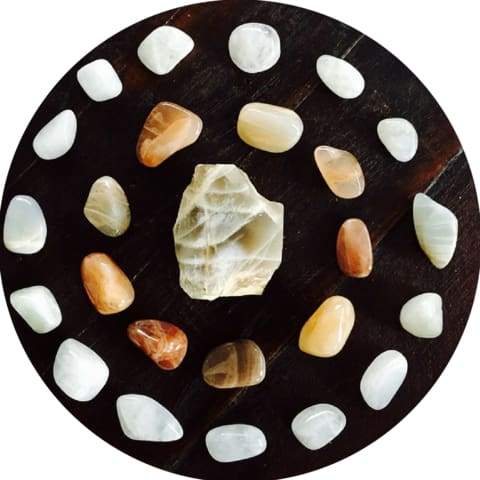Moonstone
Properties of moonstone
Moonstone belongs to the feldspar family; its chemical formula is KAlSi3O8. It is an orthoclase mineral belonging to the silicate group. Moonstone is also known by the scientific name hecatolite, or adularia when it is in crystalline form.
The reflections in moonstone range from bluish to silvery. This appearance is very similar to the reflections on the moon, hence the gem's name. Moonstone belongs to the monoclinic crystal system, has an uneven to conchoidal fracture, a vitreous luster, and a white streak. Moonstone is very sensitive to impact, with a hardness of 6 to 6.5 on the Mohs scale.
The most important deposits of moon rock are found in the United States, Mexico, Austria, Norway, Armenia, Poland, Myanmar, India, Sri Lanka and Australia.
History of the moonstone
First, it should be noted that the name "moonstone" is a trade name. The scientific names of the moonstone varieties, such as the name of the orthosis, are owed to René-Just Hauÿ, who in 1801 was inspired by the Greek term orthos, meaning "straight," referring to the stone's right-angled neckline. As for the term adularia, it comes from Mount Adule in the Swiss Alps, which is believed to be the site where this mineral variety was discovered.
Some ancient records describe and describe stones that could correspond to the moonstones we know today. It also appears that the ancients used the name "moonstone" for stones unrelated to hecatolites. Furthermore, the name "hecatolite" may have been inspired by the goddess Hecate, one of the three Greek lunar goddesses along with Selene and Artemis.
Discover our silver ring decorated with moonstone
One thing is certain: the moon became very important in ancient times. As a result, in many periods and civilizations, stones bearing the moon's name were attributed with great magical powers. For the ancients, it was a feminine and divinatory stone, a fertility stone with strange powers capable of indicating the lunar phases by changing its color.
Today, moonstone is an ornamental gemstone often cut into cabochons or small pieces to decorate ornaments and jewelry.
Benefits of Moonstone
Lithotherapy attributes great virtues to moonstone on all levels. The healing benefits of moonstone appear to be effective against various types of pain. A regulating and protective stone, moonstone helps regulate hormonal imbalances related to menopause and menstruation.
As a fertility stone, it is believed to promote female fertility and protect pregnant women through childbirth and even beyond, by supporting lactation. Moonstone is also said to be beneficial for skin problems and digestive disorders.
Discover our Moonstone bracelet
On a psychic and emotional level, moonstone dispels fears and anxieties. Its feminine dimension naturally fosters women's renowned intuition and predisposes them to positive feelings of compassion, empathy, tolerance, and tenderness toward others. Moonstone is also a stone of temperance, bringing balance and harmony. By stimulating creativity, open-mindedness, and prophetic dreams, it promotes meditation and spiritual elevation.
Generally associated with all chakras, moonstone seems to favor the Sacral Chakra. It is said to help increase the circulation of energy and bodily fluids. The astrological signs most associated with moonstone are Cancer, Aquarius, Capricorn, and Pisces.
Moonstone purification should be done regularly and carefully, avoiding chemicals and ultrasound, which can seriously damage this delicate stone. Cleanse the moonstone with tap or distilled water. And what better way to recharge it than with the moon?





















